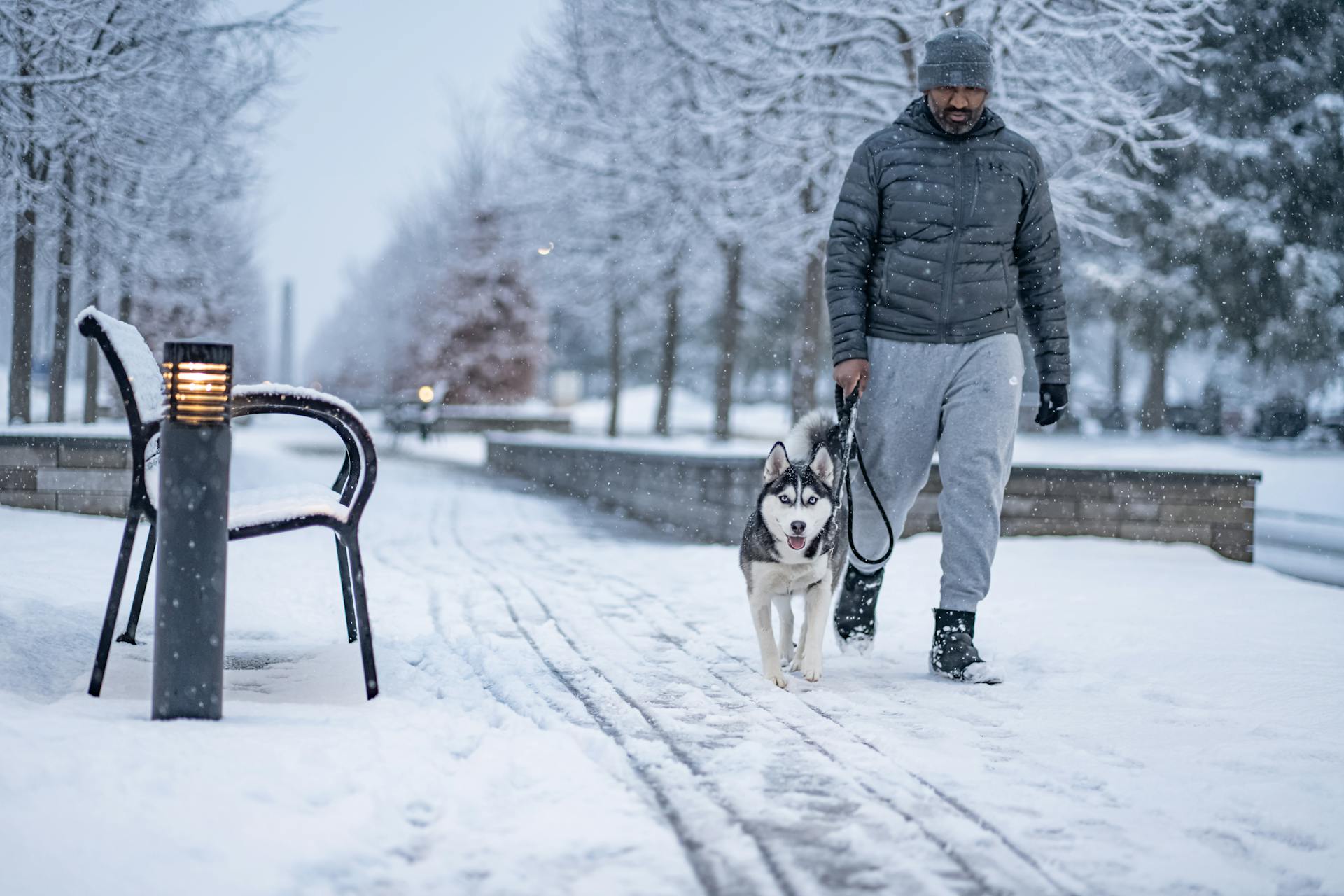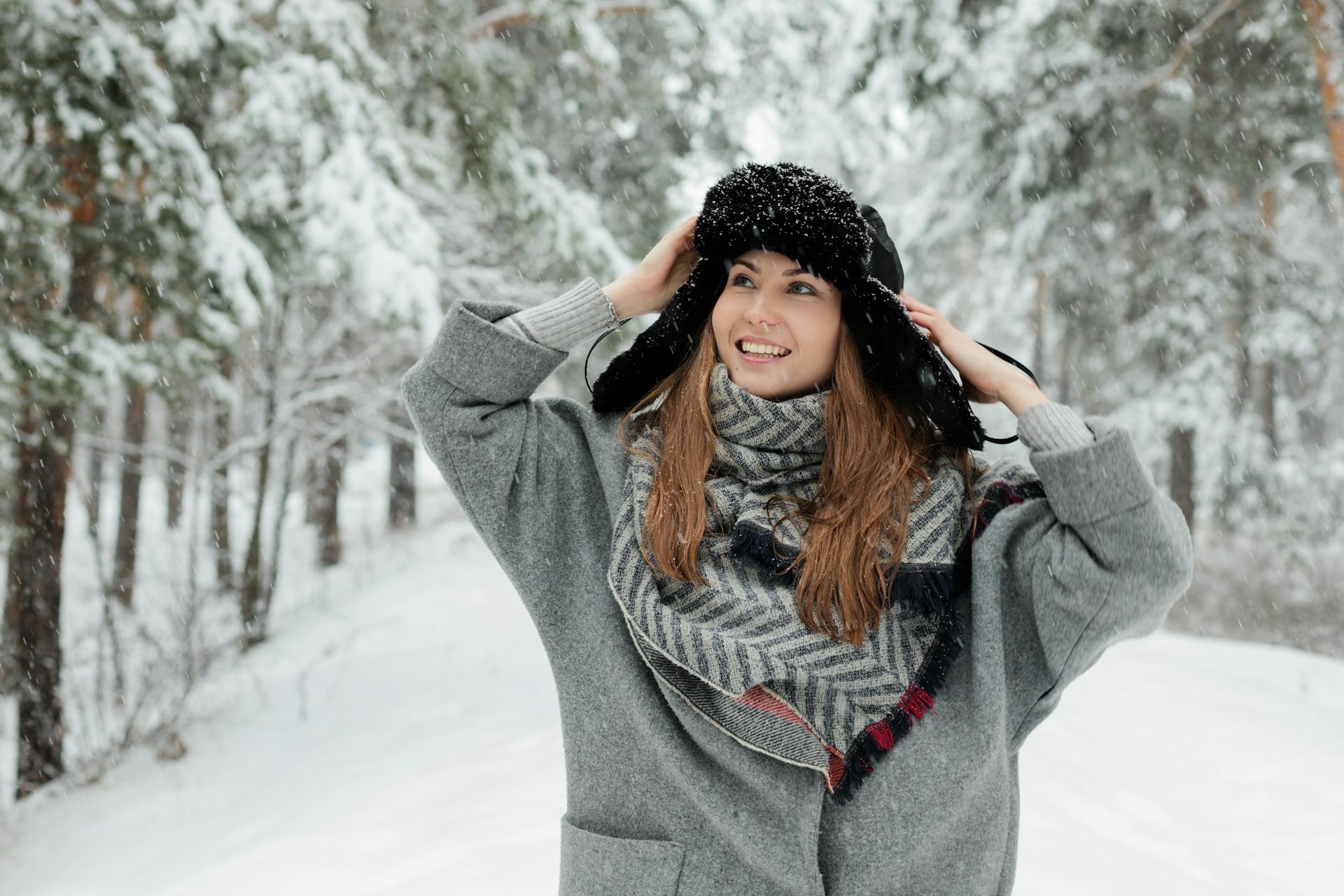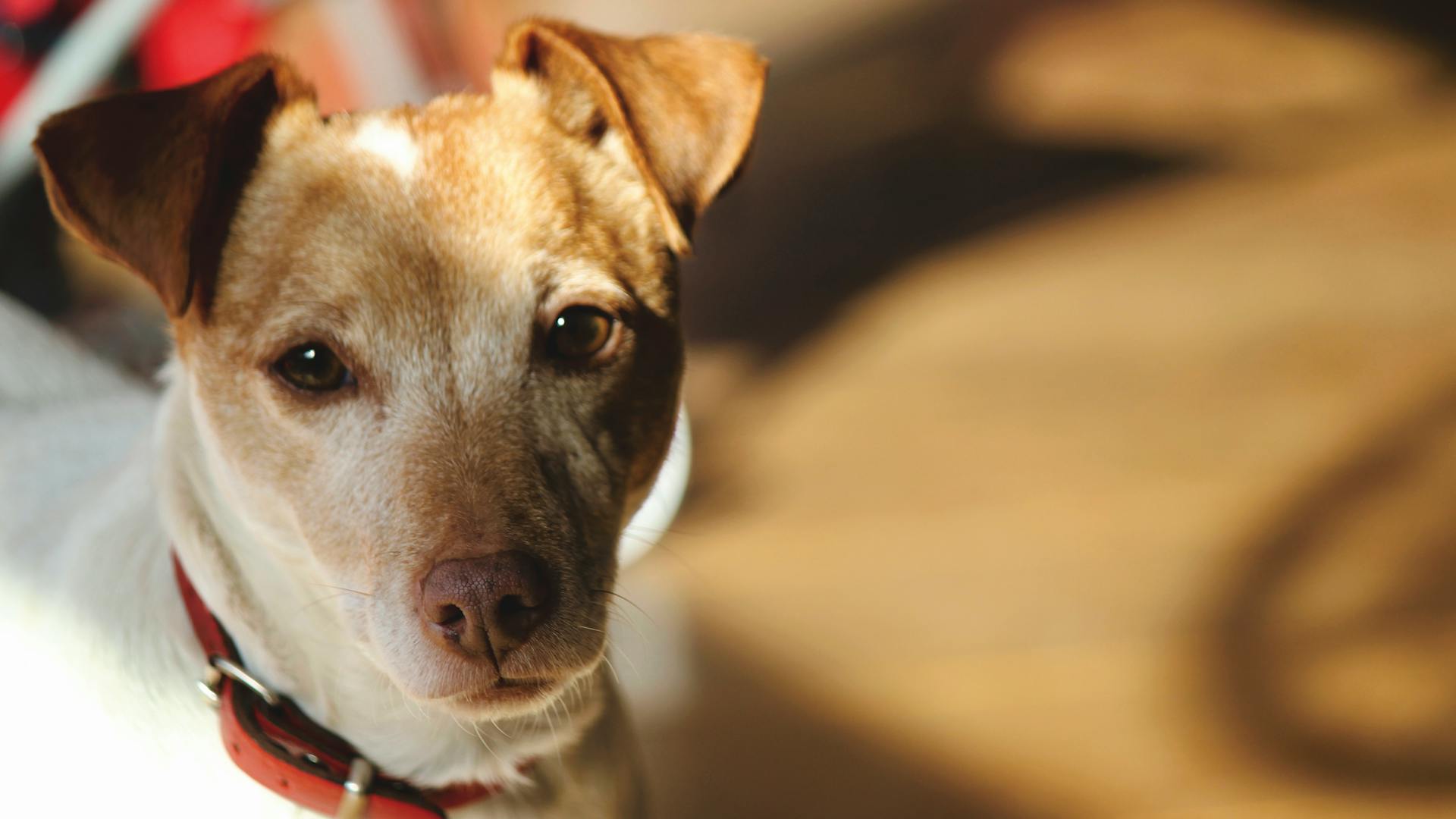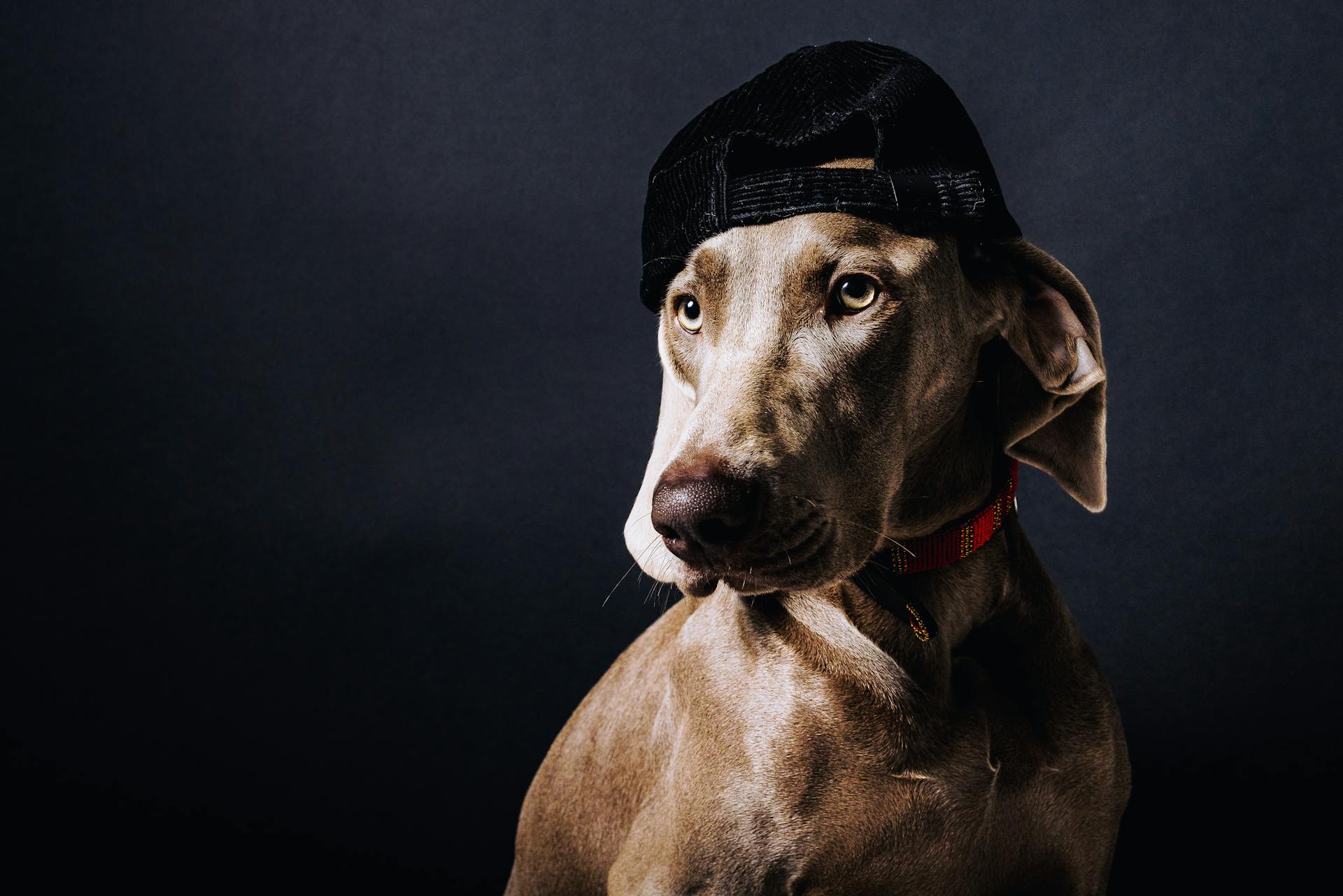
Huskies are indeed double coated dogs, meaning they have two layers of fur. This unique coat is made up of a soft undercoat and a coarser outer coat.
Their double coat is designed to keep them warm in freezing temperatures and cool in hot weather. The undercoat traps warm air close to their skin, while the outer coat repels water and snow.
Huskies shed heavily, especially during shedding season, which can be a challenge for their owners. They lose their thick undercoat to make way for a new one.
Regular grooming is essential to prevent matting and tangling of their fur. This includes daily brushing and occasional bathing.
Take a look at this: Do Chihuahuas Have Hair or Fur
What is a Double Coat?
A double coat is a type of dog fur that consists of two distinct layers of fur - an undercoat and a topcoat.
The undercoat is the soft, dense layer of fur that grows close to a dog's skin and provides insulation by trapping air close to the body.
This undercoat is designed to keep dogs warm in cold weather and consists of a fine, downy texture.
The topcoat, also known as the outer coat, is the longer, coarser layer of fur that grows on top of the undercoat.
It protects the skin against elements like rain, wind, bug bites, and UV rays.
Double-coated breeds of dogs come in a variety of sizes, shapes, and colors.
Their coats are designed to protect them in both heat and cold weather, so they require special attention.
Removing dirt, debris, and dead hair from a double-coated dog's coat is crucial for maintaining their health and well-being.
Take a look at this: Do Rottweilers Have an Undercoat
Husky's Coat
Husky's Coat is a double-layered wonder that keeps them warm in freezing climates.
Their thick coat of fur is a beautiful sight to behold, but it can also be a nuisance to owners who aren't prepared for the amount of shedding that huskies do.
This coat is made up of two main kinds of fur: a thick undercoat and a coarser outer coat.
The undercoat traps warm air next to their skin, while the outer coat repels water and snow.
This unique combination keeps huskies warm even in the coldest temperatures.
Grooming and Shedding
Huskies shed their coat twice a year, typically in the spring and fall, and it can last for several weeks.
This process is called "blowing their coat" and can result in a lot of hair around your home.
The main purpose of shedding is to regulate their body temperature, so they can stay cool in the warmer months and warm in the colder months.
Huskies have a thick undercoat that helps keep them warm in the winter, but when the weather warms up, they shed it to stay cool.
In the spring, they shed their heavy undercoat quickly to grow in a lightweight undercoat for the warmer weather.
In the fall, they shed their lightweight undercoat to grow in a thick, insulating coat for the cold weather.
Brushing your husky regularly can help remove dead hair from their coat and reduce the amount of shedding in your home.
It's essential to be patient, as huskies typically only blow their coat a couple of times per year, and the shedding process doesn't last forever.
Broaden your view: Grooming Your Own Dog
Husky Care and Maintenance
Huskies shed, or "blow their coat", twice a year, usually in the spring and fall.
This process can last for several weeks and result in a lot of hair around your home.
You need to accept that shedding is a part of owning a husky.
Regular brushing is essential to remove dead hair from their coat and cut down on shedding.
Huskies typically only blow their coat a couple of times per year, so patience is key.
Brushing your husky regularly will help reduce the amount of shedding in your home.
You should be prepared to deal with hair around your home if you decide to own a husky.
Suggestion: Curly Hair Cavapoo
Husky's Double Coat in Summer
Huskies are double coated breeds, which means they have a thick undercoat and a topcoat that protects them from the elements.
Their undercoat is designed to keep them warm in cold weather, but in the summer, it can actually make them hotter.
If you shave a double-coated dog like a Husky, the new hair will grow back, but the undercoat will grow first, and the texture of the new coat can be sticky and prone to getting twigs and plants stuck in it.
Regular grooming, including a de-shell at the beginning of each season, can help keep their coat in check and ensure their undercoat is doing its job as an insulator.
To keep your Husky cool in summer, you can brush them regularly and bathe them, then dry them with a high-velocity drier to push out the undercoat.
Keeping Breeds Cool in Summer
Keeping your Husky cool in summer requires some special care. The undercoat is designed to keep them cooler in summer and warm in winter, but it needs to be shed regularly to work properly.
In summer, your Husky will shed the soft undercoat, leaving behind the guard hairs. Without the undercoat, the air can't circulate beneath the outer hair and can't keep the skin cool.
Shaving your Husky can ruin their coat, especially if you shave a double-coated breed like a Husky. The new hair will grow back, but the undercoat will grow first, making the texture sticky and prone to getting tangled with grass seeds, twigs, and plants.
Brushing alone won't get all the undercoat, but brushing in conjunction with regular bathing can promote shedding and help remove the dead hair. This will allow the outer coat to work as an insulator, keeping your Husky cooler in summer.
The guard hairs are slower to grow, but they're essential for protecting your Husky from the sun's rays and insect bites. If you shave your Husky, the guard hairs will grow back, but it may take some time.
To keep your Husky cool in summer, it's essential to groom them regularly and have a de-shed at the beginning of each season. This will remove all the dead hair and ensure the outer coat can work as it's intended.
The Bottom Line
Huskies are a beautiful, popular breed, but they shed a lot, especially during the summer months.
If you're not prepared to deal with the shedding, a husky might not be the right breed for you. Regular brushing and baths are a must to keep their coat under control.
Brushing your husky frequently can help reduce the amount of loose hair, but it's still a lot of work. Adopting a husky mix might be a better option if you're concerned about shedding.
Huskies make wonderful, loyal companions if you're willing to put in the effort to care for their coat.
A unique perspective: Do Collies Shed a Lot
Frequently Asked Questions
Why can't you cut husky hair?
Husky hair is best left uncut to maintain their natural insulation and protection from UV rays, which is vital for their health and well-being. Cutting their coat can disrupt this crucial process.
What happens if I shave my husky?
Shaving a Siberian Husky exposes its skin to the sun and insects, increasing the risk of skin problems, including sunburn, allergies, and skin cancer. This can lead to serious health issues if not addressed properly.
Featured Images: pexels.com


